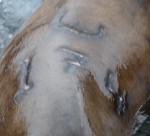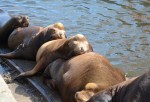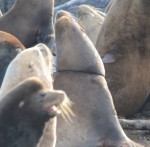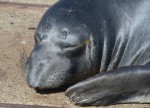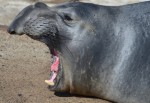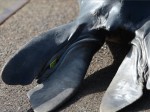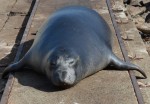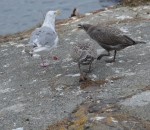The wind blew north by northeast at 5 – 10 knots for most of today. Morning fog seemed to be blown out of the southeast but stayed on the American side of the Strait today and there was sunshine mid-day. By evening the wind had switched to west and the clouds had thickened along the Olympics and out to sea. The so-called marine air (aka fog) out to the west, had a yellowish colour of the kind you see in the haze coming into Korea from China. There may be some leftover forest fire smoke in that mix as yellow is not a normal colour for fog. The barometer continued the climb it started yesterday and reached 1008 hPA this evening. Forecasters are calling for light and variable winds and showers. I have my wheelbarrow out to catch any moisture coming from the sky and it is just starting to spit.
There were twenty visits by commercial watching vessels observed in the Ecological Reserve today and highlights included the sea otters, sea lions, elephant seals and the very large explosions coming from Rocky Point. The explosions sarted late morning and ran through the afternoon. Quite often the blasts do not seem to effect the animals but today they seemed extra substantial, of a magnitude and recurrence that cleared the islands (mostly) of sea lions, several times. This made for some good sea lion watching in the water, as that is where they spent quite a bit more time than usual, today.
The sea lions also spent a lot of time repeatedly running for the water and then slowly climbing back out and hauling themselves up to resting spots. I doubt that this is part of a normal energy budget during moulting season. The Northern Elephant Seals remained undisturbed by the large explosions and appeared to sleep right through the brouhaha. All the moving around made it easier for photograph to see neck-laced sea lions and brands without worry of disturbance. Two Northern Elephant Seals visited Great Race today. The young male #5850 who was here both last fall and last spring was here again today with a little female. He has really grown in the last year, especially since his spring moult. Definitely filling in and stretching out his skin. The only tag left is on the inside of his left back flipper.
There were no obvious effects from the explosions on the birds. Many of the adult Glaucous-winged Gulls have returned to their territories and are standing around on their “spots”. It almost seems as if some of them are experiencing empty nest syndrome: some pairs are doing a bit of redecorating, carrying nesting material around, acting out behaviours observed early in the nesting season last May, but with less verve, and of course ‘going gray’. The white head of the adult Glaucous-winged Gull is only white during breeding season and turns into an alternate, mottled gray during the winter. Many are transitioning now. Some adults are still feeding young gulls, although most of the young are also out learning how to forage. The youngest, or perhaps slowest one to develop, is the last one learning how to fly and spends quite a bit of time stretching its wings, taking little hops with the wings out and running while flapping. It will be aloft soon. The last Canada Goose family took flight today and hope is that they will flock off.
Chores were routine except for another plumbing challenge. There were no visitors.


